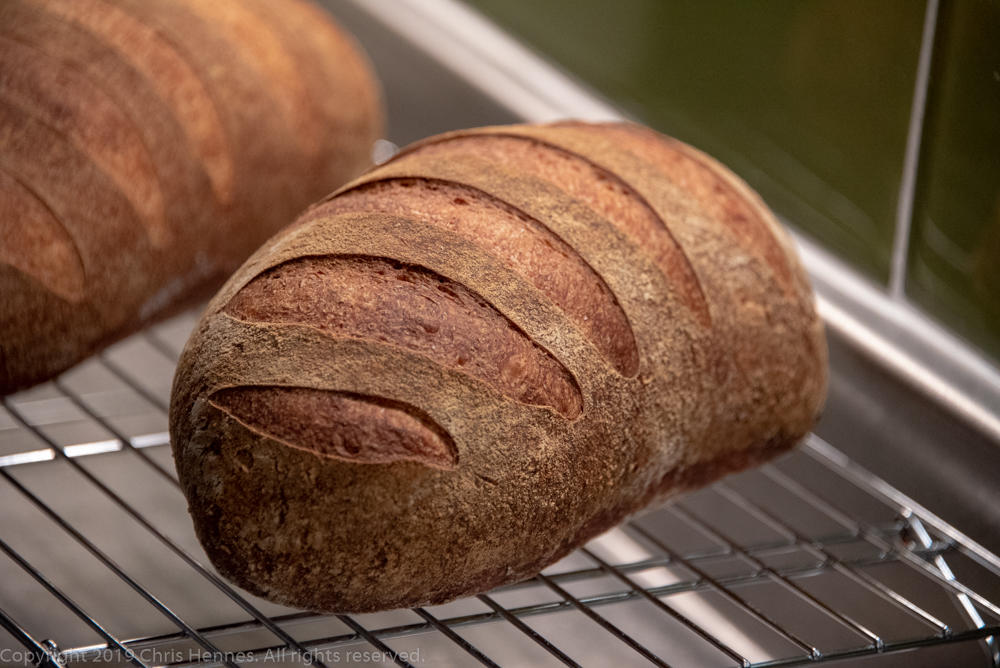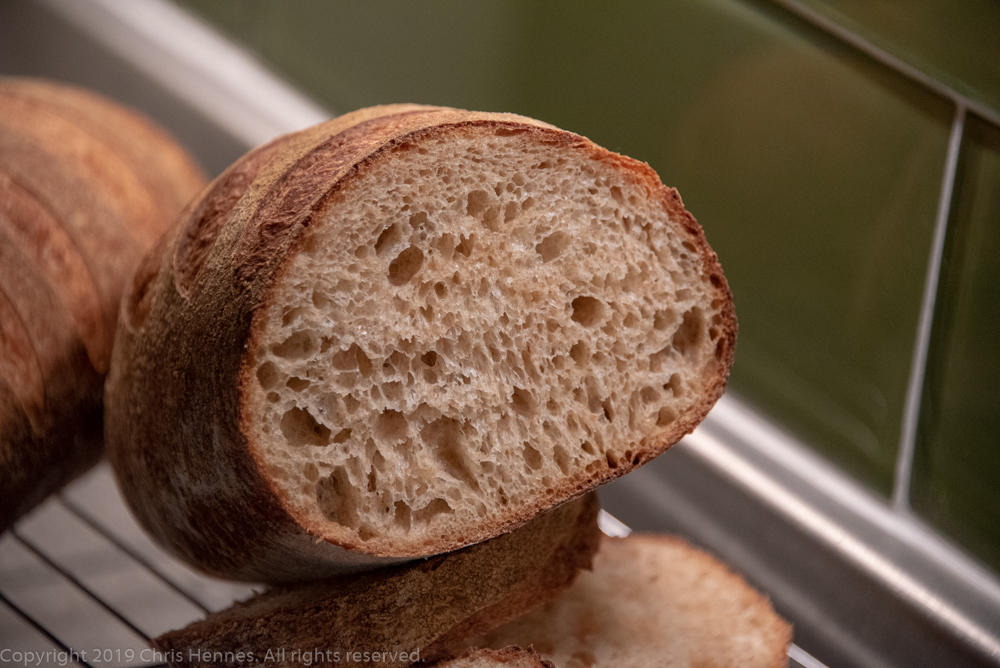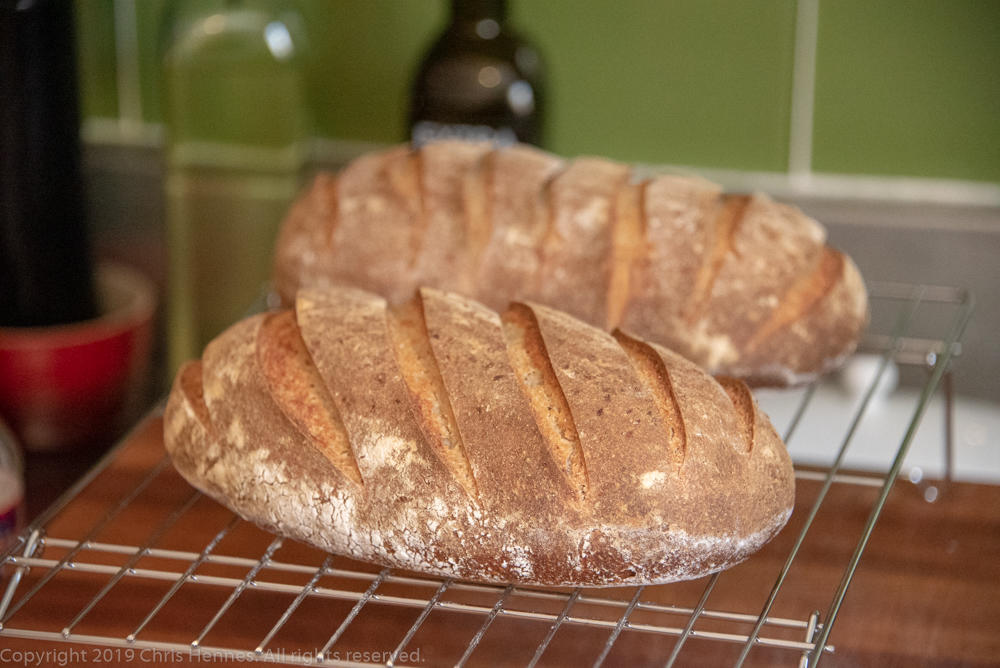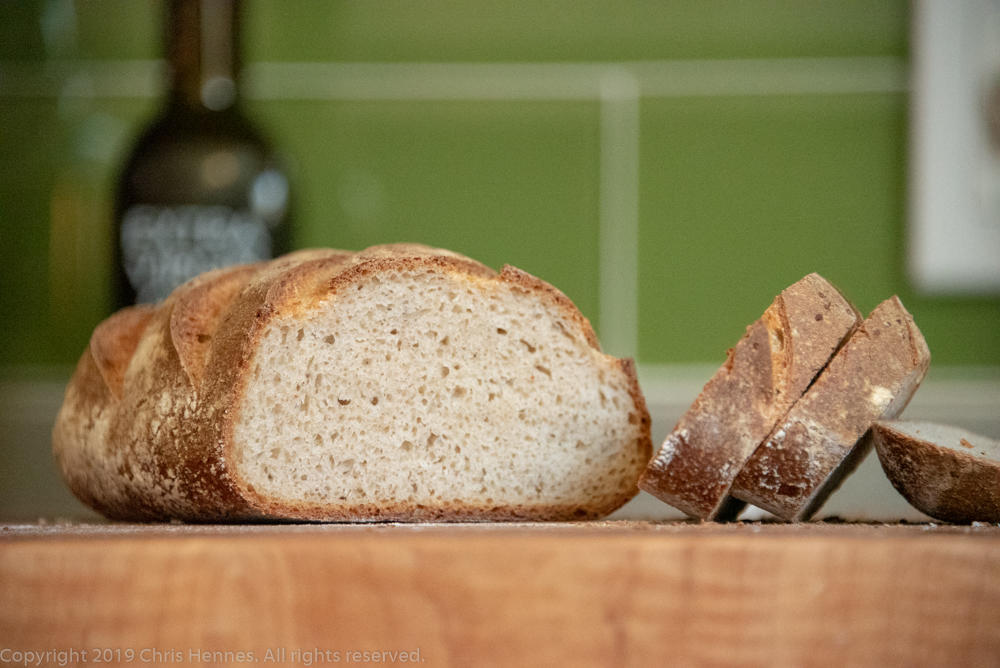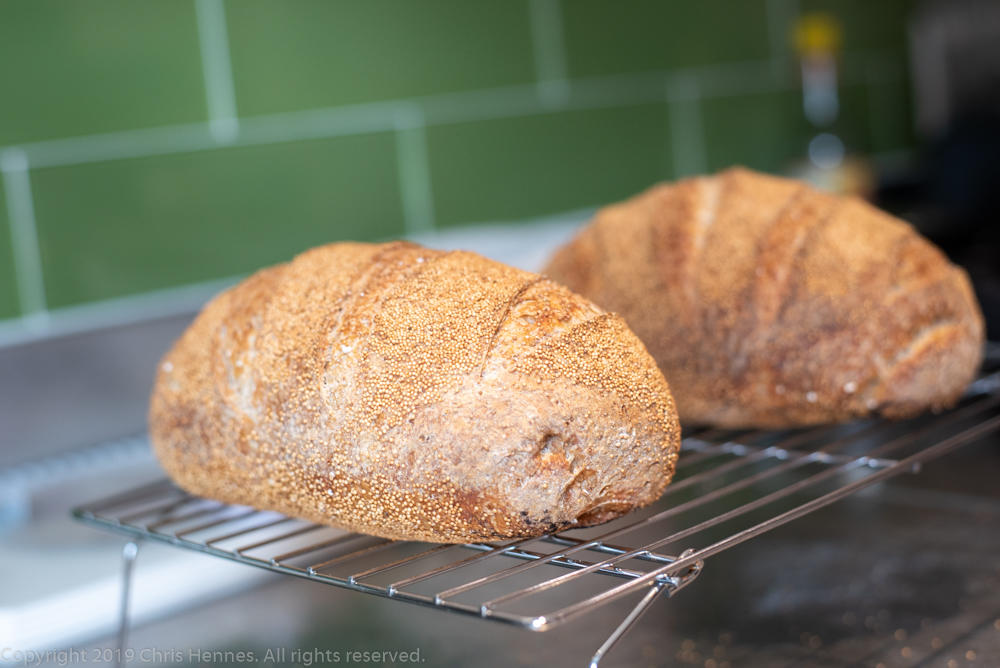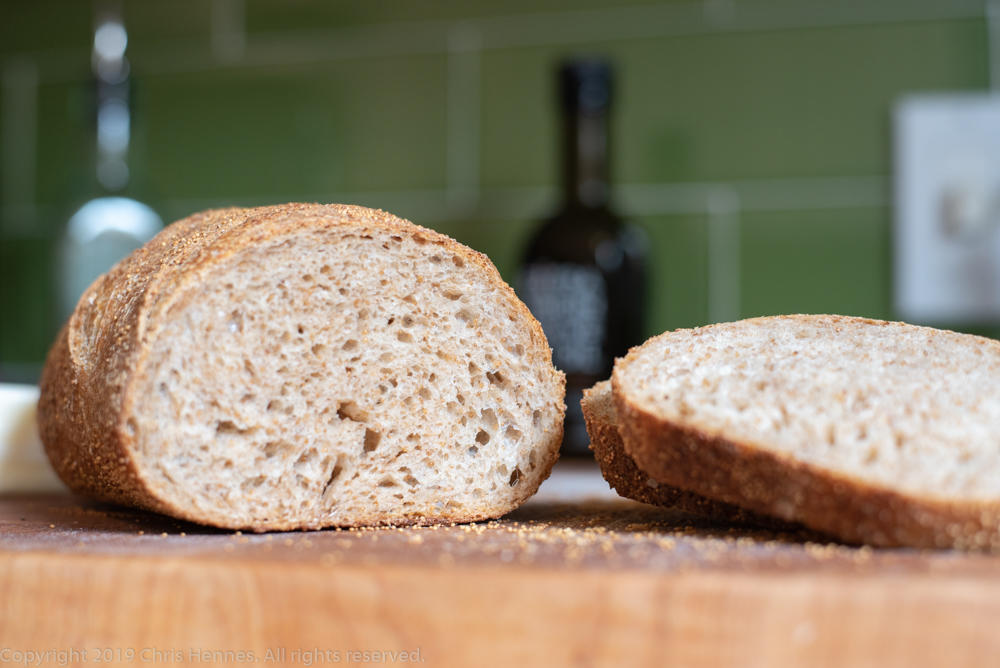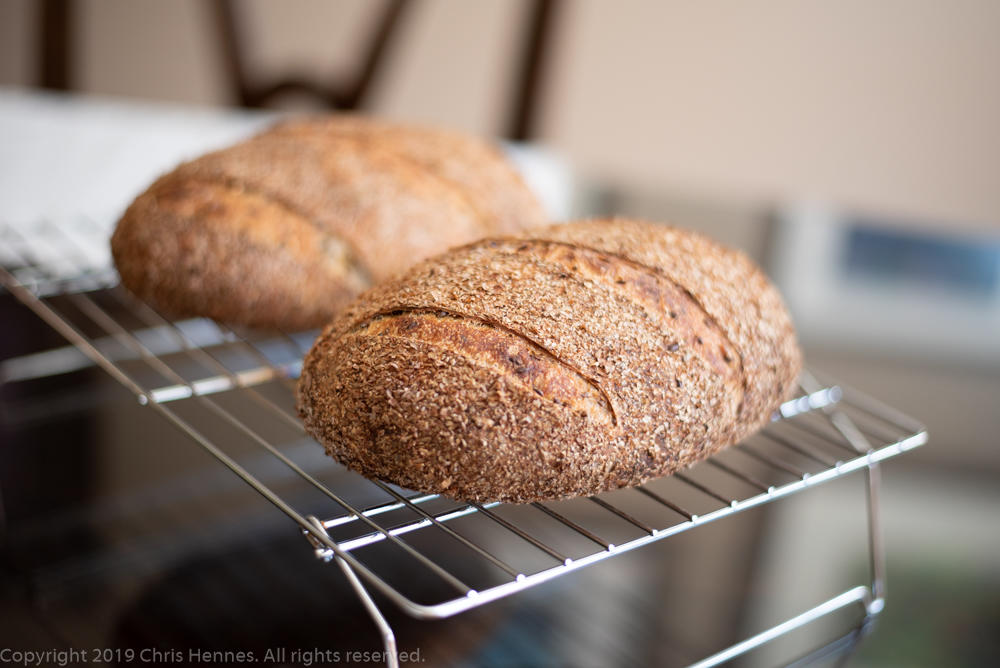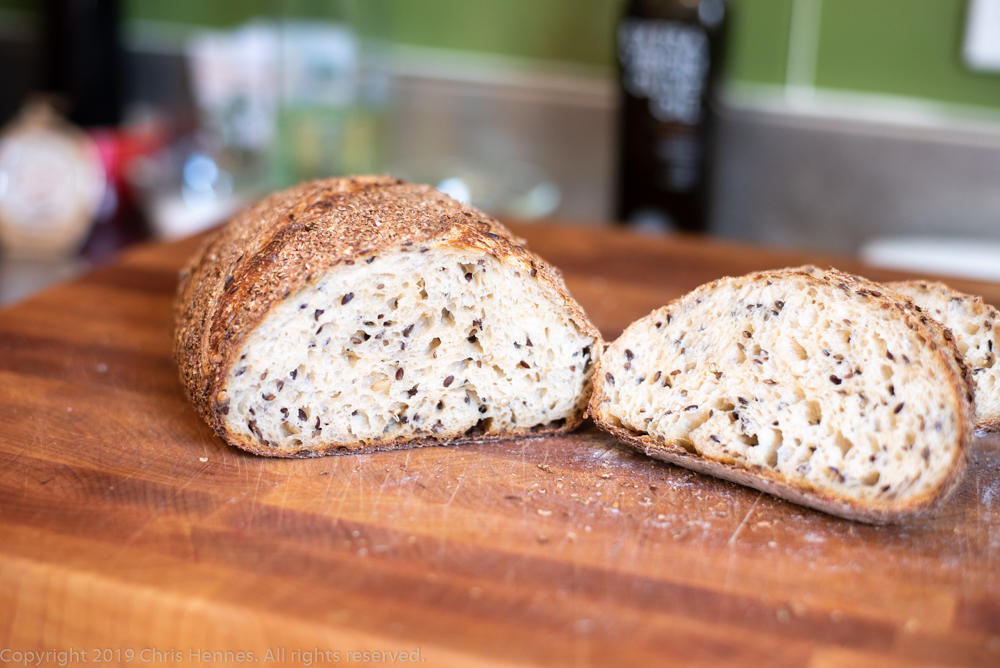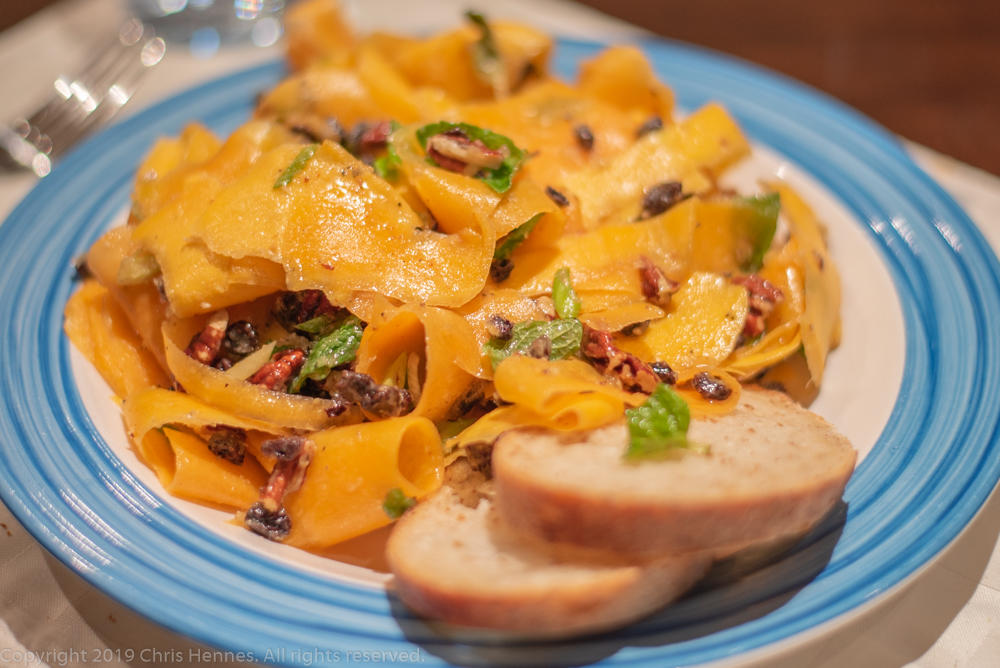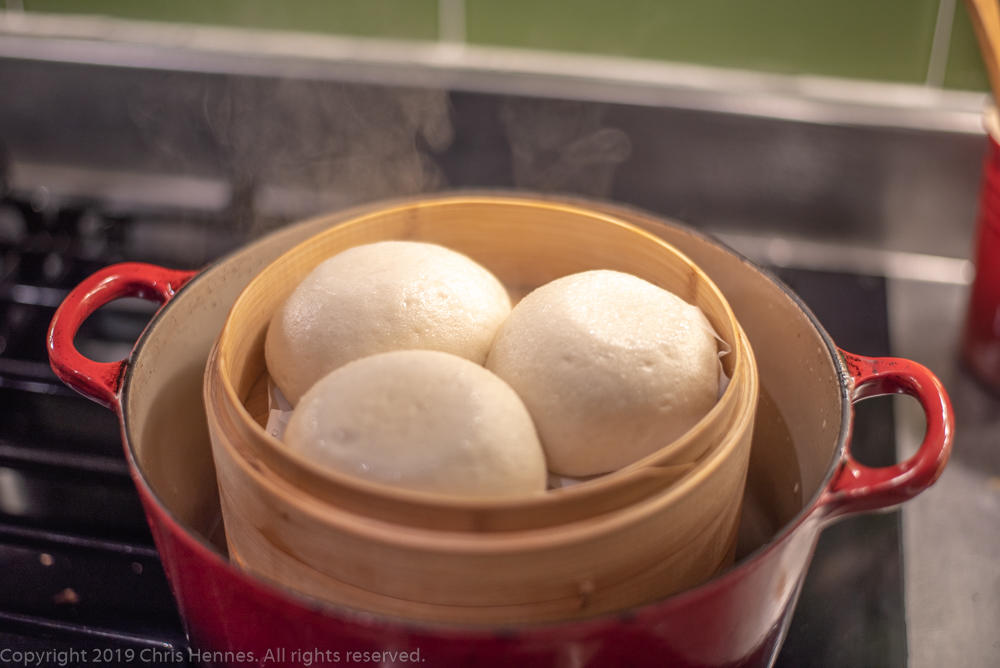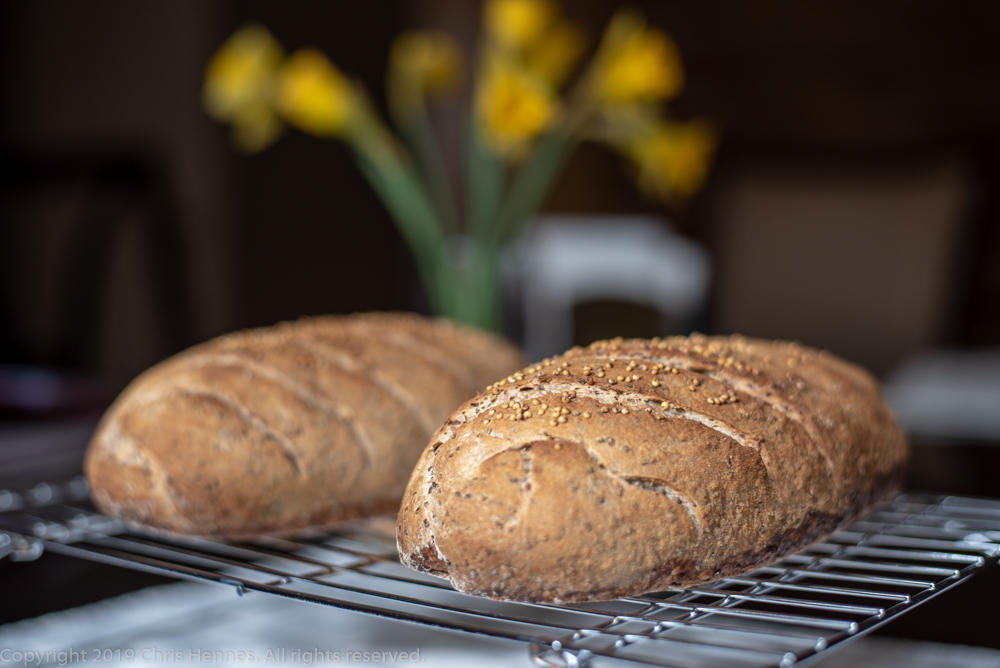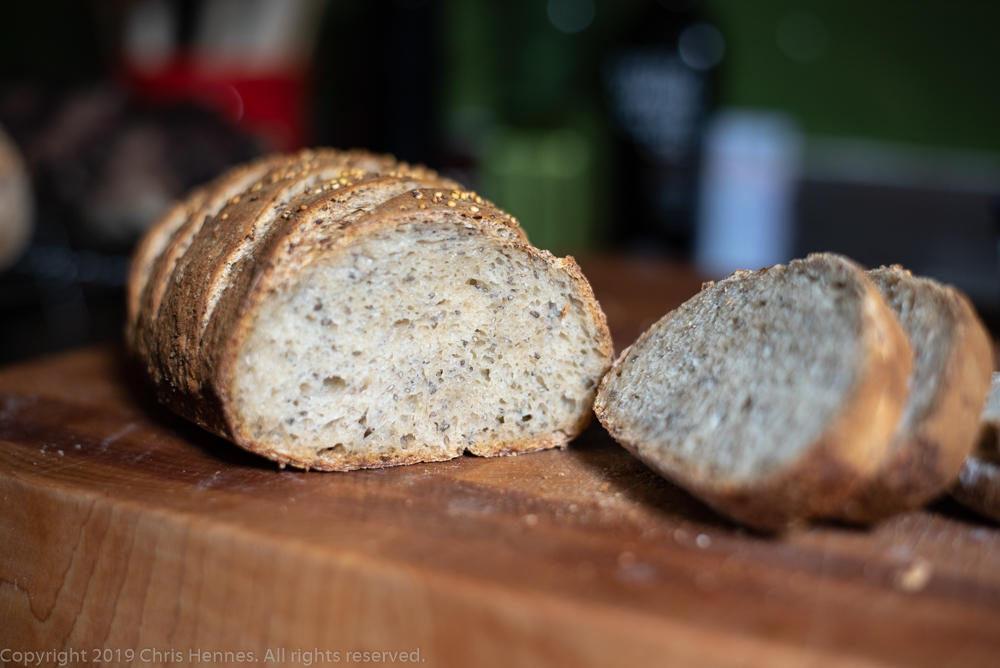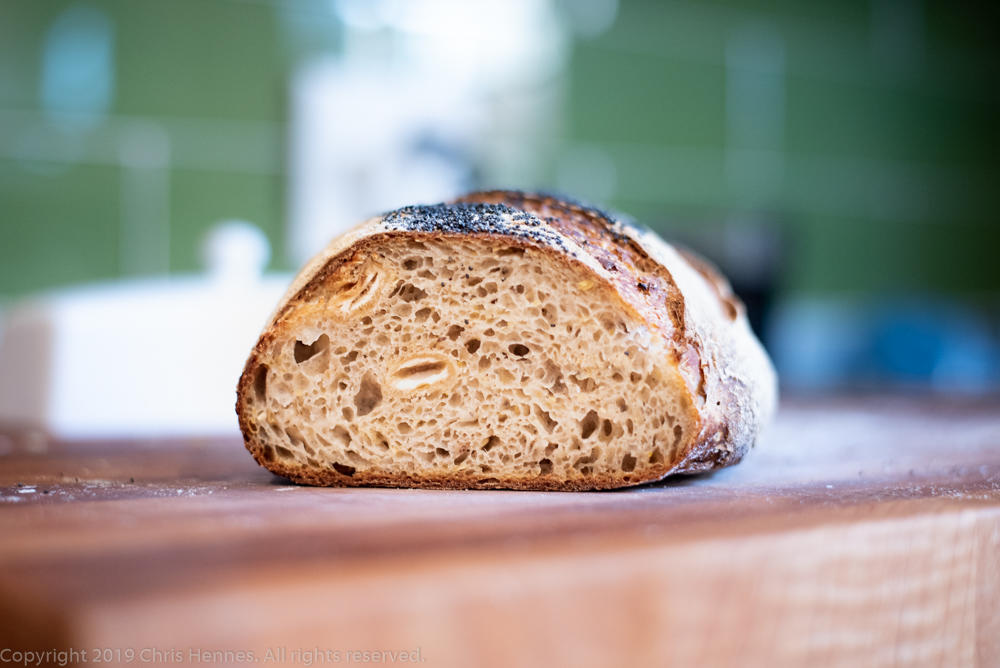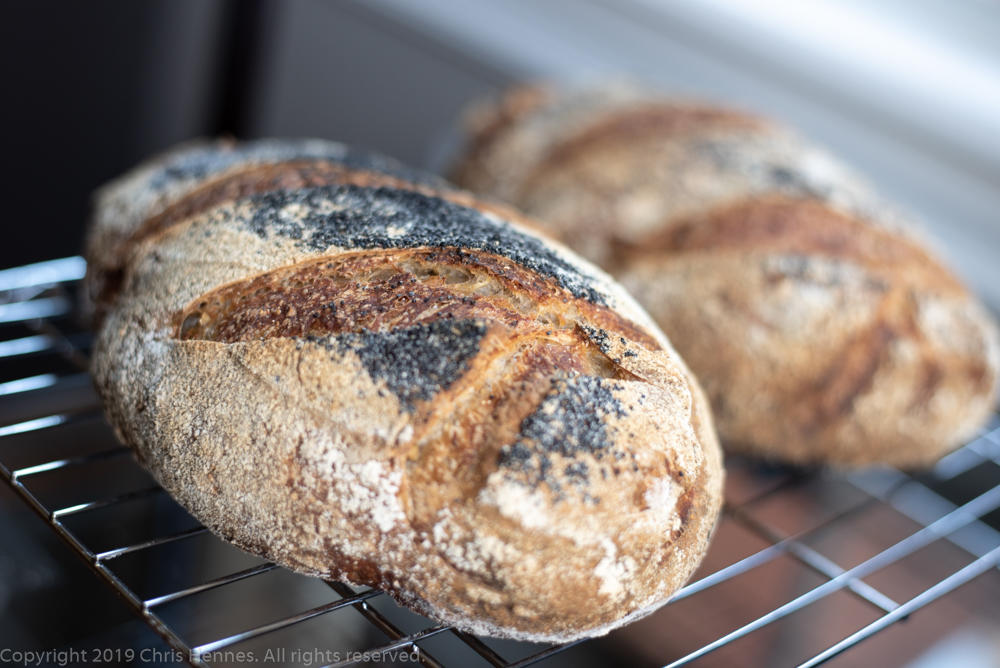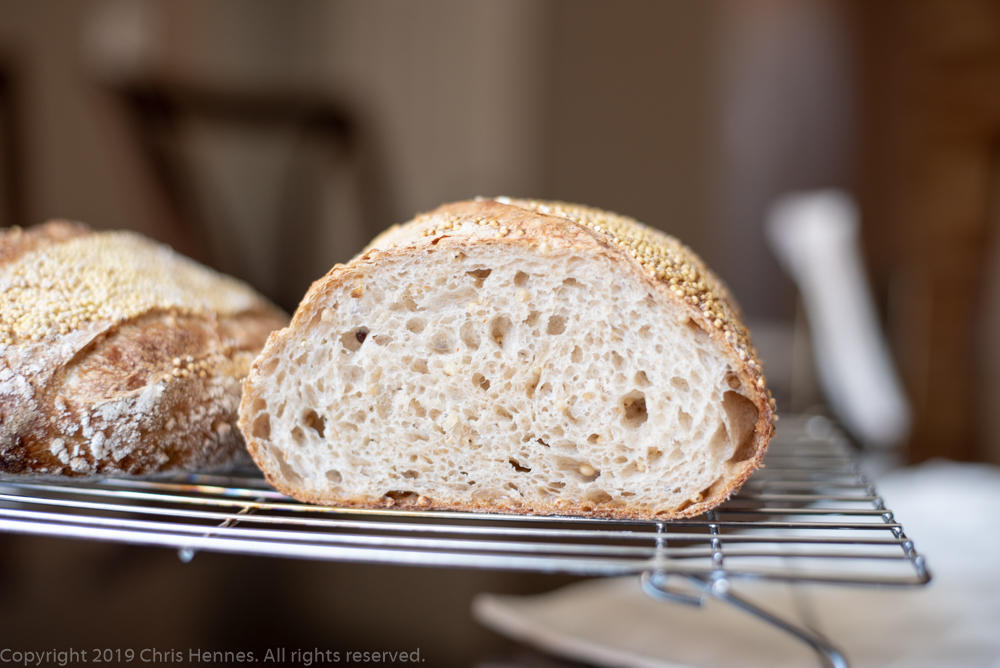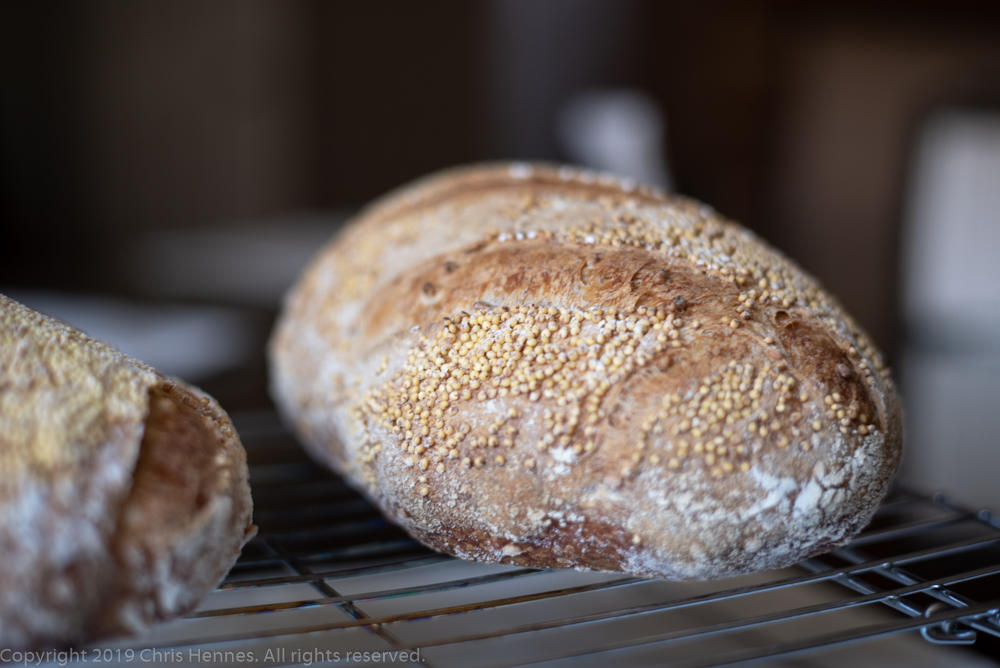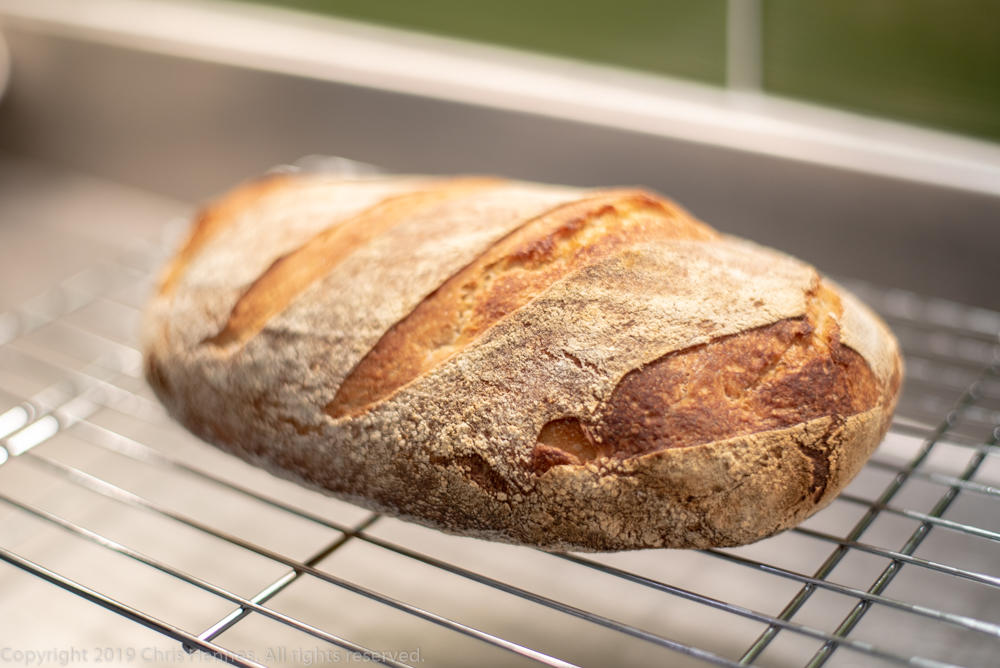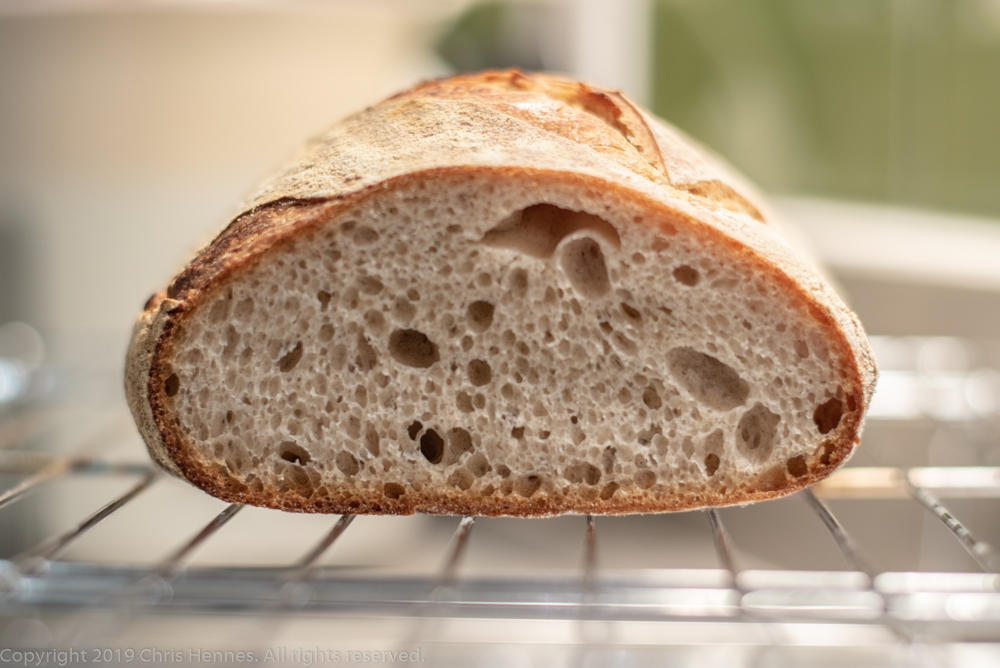-
Posts
10,190 -
Joined
-
Last visited
Content Type
Profiles
Forums
Store
Help Articles
Everything posted by Chris Hennes
-

Baking with Myhrvold's "Modernist Bread: The Art and Science"
Chris Hennes replied to a topic in Pastry & Baking
Modernist Ancient Grain Bread (KM p. 107) For their Modernist take on ancient grain breads they decided to go with a "second-chance sourdough"-style construction. I don't think there's any real reasoning behind it, they just thought it was nifty. So it's really a French lean bread with an inactive levain inclusion at about 35%, plus a 48% ancient grain flour substitution, and an optional 7% sweetener. There's a lot going on there, so I kept it simple, just using spelt as a ancient grain and sorghum syrup as the sweetener, with no inclusions or complicated flour blends. So far spelt is my favorite of these grains, and I enjoyed the slight sweetness from the sorghum syrup, so this bread was a success. I think "in real life" I'd probably just make it as a straight sourdough, though, I don't often have a need for using up inactive levain. -

Baking with Myhrvold's "Modernist Bread: The Art and Science"
Chris Hennes replied to a topic in Pastry & Baking
60% Buckwheat Flour Sourdough (KM p. 106) This is a dedicated recipe in the same spirit as the other "ancient grain" loaves, but with only buckwheat, and no inclusions. The recipe is a bit wonky: it's called 60% buckwheat in the recipe title, but you don't actually use 60% buckwheat, you use just under 50%. The "Net Contents" listing is all kinds of messed up, so I really don't know if it's the recipe that's wrong, or the title, or both. All that said, my loaf came out a bit on the dense side, with fairly minimal oven spring. The dough was lower hydration than they normally call for, which may have accounted for part of it. The flavor is good, very buckwheat-y, but I don't have a lot of confidence that the recipe is actually the one they intended to publish. -

PLANNING...an eG Gathering in STL for Bulrush
Chris Hennes replied to a topic in The Heartland: Dining
We booked our flights yesterday So we're definitely confirmed now! -

Baking with Myhrvold's "Modernist Bread: The Art and Science"
Chris Hennes replied to a topic in Pastry & Baking
When I did it here I tried a couple of different techniques, but had the most luck putting a smaller amount of the topping in a small bowl and dipping a few, then discarding the remainder of the bowl contents and repeating the process. -
As usual, be careful taking random advice off of the internet! A well-established starter can be carried forward with many different ratios, and on many different feeding schedules. Anyone who tells you that it must be done a certain specific way is simply reporting their preferred method, not a hard-and-fast rule. Broadly speaking your goal is to make sure that your yeast and bacteria get enough to eat, don't run out of food before you have a chance to feed them again, and have a relatively stable pH. You don't mention what temperature you are keeping your starter at: if it's at room temperature you might be surprised by how much food it can run through! As a good starting place, Modernist Bread's preferred feeding schedule is once every 24 hours, storing the starter at 55°F, and feeding 4x the weight of the starter in flour and an equal amount of water. For your example, then, you would feed 8oz of flour and 8oz of water to 2oz of starter every 24 hours, discarding (or baking with) the remaining starter. Personally, as someone who only bakes once per week, I find this a bit wasteful in terms of discarded starter, so I store mine in the refrigerator. On Friday morning I take it out of the fridge and put it on the counter (70°F or so). At 10pm or so I feed it according to the MB ratio. I put some of it in the fridge for the next week, and leave the rest on the counter overnight for the next day's baking. It's ready to use first thing the following morning.
-

Baking with Myhrvold's "Modernist Bread: The Art and Science"
Chris Hennes replied to a topic in Pastry & Baking
Ancient Grain Bread: Spelt, Dark Rye, and Bulgur (KM p. 105) This week's entry is 25% spelt, 10% dark rye, and 5% bulgur. I couldn't find bulgur wheat as a flour, so I ground it myself in the blender, then sifted it through a fine mesh. The inclusion is toasted amaranth, and the topping is amaranth, which makes a tremendous mess; probably even more so than millet. The bread is quite good: a nice texture and good flavor from the spelt. I didn't pick up much in the way of rye flavor, though. 10% is probably below the lower limit of detectability, to my palate anyway. That's probably true of a lot of these ancient grain blends: it's obvious there is something different in each of them, but the exact blend is not discernible. I will probably play around some with going the whole 40% as a single grain to isolate the tastes of the individual grains. Next week's entry will be predominantly buckwheat, which they have a recipe for. After that, we'll see... -

Starting a high profile new restaurant (after closing another)
Chris Hennes replied to a topic in Restaurant Life
Except that Rob called them "elevated plates" - so unless he's going all Sweeney Todd on us I don't think that's it! -
Have you had a chance to use one of them?
-

Baking with Myhrvold's "Modernist Bread: The Art and Science"
Chris Hennes replied to a topic in Pastry & Baking
Ancient Grain Bread: Durum, Barley, and Quinoa (KM p. 105) 20% durum wheat flour, 10% each barley and quinoa flours, and the balance high-gluten bread flour. Inclusions are toasted flax seeds and sprouted brown rice. I've never thought to sprout rice before, and the book doesn't actually contain any instructions for that one. They have a long list of other grains to sprout, but despite a recipe calling for it, no info on sprouting rice. It turns out it's much slower than the other grains, or perhaps needs to be soaked longer. I actually started sprouting the rice the Tuesday before last, and it was just now ready as an inclusion this weekend. I soaked it for 12 hours and then followed the usual procedure of rinsing twice per day, but it took a long time to germinate. At any rate, it worked fine as an inclusion, but was overshadowed by the toasted flax seeds, both in terms of flavor and texture (not to mention appearance). Overall the bread is quite good, I'll probably make this combination again. -

Cooking with "Six Seasons: A New Way with Vegetables," by Joshua McFadden
Chris Hennes replied to a topic in Cooking
Raw Winter Squash with brown Butter, Pecans, and Currants (p. 377) I'm not sold on the texture of raw winter squash. I used a vegetable peeler to make the ribbons, so I probably couldn't realistically get them much thinner, but I still found them to have a bit too much chew to them. The flavors in this salad are good, but I might be inclined to try to heat up the squash and get it to soften just the tiniest bit. -

Baking with Myhrvold's "Modernist Bread: The Art and Science"
Chris Hennes replied to a topic in Pastry & Baking
Steamed Buns (KM p. 388) This is pretty typical recipe for steamed buns, although they go to great pains to point out that you can really steam pretty much any bread recipe. Of course you don't end up with a crisp crust, but sometimes that's desirable (I guess. Maybe.). Filling these is optional, but I made a sort of Sichuan-esque filling with black beans, chili oil, Sichuan peppercorns, dark and light soy sauce, and shaoxing. Overall I was happy with them: I've never been to China so can't compare to the buns there, but they were certainly as good as any I've had in the US. Bonus points for being one of the few breads where eating them directly after baking doesn't brand you a barbarian. ' -

Baking with Myhrvold's "Modernist Bread: The Art and Science"
Chris Hennes replied to a topic in Pastry & Baking
@Kmanim I didn't check the exact proportions, but that's the gist of it, anyway. You only need enough to get the bagels dipped, but it can be hard to deal with smaller quantities, so I typically make 1kg batches, as that recipe suggests. I'm sure you could get by with a half batch easily enough, though. -

Baking with Myhrvold's "Modernist Bread: The Art and Science"
Chris Hennes replied to a topic in Pastry & Baking
Ancient Grain Bread: Teff, Einkorn and Millet (KM p. 103) This week's "ancient grain" entry uses predominantly einkorn (25%) with a little teff (5%) and a little millet flour (10%). The inclusion is chia seeds, and the topping is millet (which I went lighter on this time). Overall I didn't get much oven spring, so while the flavor was fine, the texture was a bit on the chewy side. Not a bad bread, but I probably won't rush out to make it again. -

Baking with Myhrvold's "Modernist Bread: The Art and Science"
Chris Hennes replied to a topic in Pastry & Baking
Well, they look like bread. How is the texture? -

PLANNING...an eG Gathering in STL for Bulrush
Chris Hennes replied to a topic in The Heartland: Dining
I've got a +1. -

Baking with Myhrvold's "Modernist Bread: The Art and Science"
Chris Hennes replied to a topic in Pastry & Baking
Ancient Grain Bread: Buckwheat, Corn and Sorghum (KM p. 105) This follows the same basic recipe as the Master Ancient Grain bread. The grains are swapped out, vital wheat gluten is added, and the hydration is tweaked. The inclusions this time around are sprouted buckwheat and freeze-dried corn. Overall I'd say the bread is good but not great, and I don't care for the freeze-dried corn inclusion (it gets gummy). Their photo appears to show a much darker crumb than I ended up with, which is interesting. -

PLANNING...an eG Gathering in STL for Bulrush
Chris Hennes replied to a topic in The Heartland: Dining
I can now, I had to consult with my travel planner a.k.a. my wife -- 1 - June 21-23 (totally open) 2 - July 12-14 (would miss a non-critical meeting) 3 - July 26-28 (have show tickets that Saturday, less than 50% chance I'd make it) 4 - May 31-June 2 (Cannot attend at all) -

PLANNING...an eG Gathering in STL for Bulrush
Chris Hennes replied to a topic in The Heartland: Dining
I can't make May 31-June 2, but the other three are about equal for me. I work at a public library so summer is my busy season: I can make a Saturday dinner, but might not be able to do anything else. -

Baking with Myhrvold's "Modernist Bread: The Art and Science"
Chris Hennes replied to a topic in Pastry & Baking
Depends on how sticky the dough is. The ancient grain bread is quite sticky so I just sort of pull the outside around with my thumbs to pull it taught, rolling it a bit to get the shape right. I am proofing in bannetons, which also helps. -

Baking with Myhrvold's "Modernist Bread: The Art and Science"
Chris Hennes replied to a topic in Pastry & Baking
Ancient Grain Bread (KM p. 102) The "ancient grain" section of the book contains, as usual, a "Master Recipe", a "Modernist Variation," and a dozen or so specific ingredient combination suggestions. It also contains a basic formula for developing your own. So for my first attempt I made the Master Recipe exactly as written. The basic idea is to blend 60% high-gluten wheat bread flour and add 40% of the "ancient grain" flour(s), plus standard wheat-based liquid levain. Their recipes mostly use blends of three different alternate grains: in this case, Kamut, Emmer and Spelt. As an inclusion the Master recipe has you add sprouted sorghum, and it uses pearl millet as a topping. First things first: it's fantastic. Definitely one of the best breads I've ever had. I found the millet topping a bit too crunchy, and I added too much of it, I think (it goes everywhere when you slice!). But the basic flavor of the bread is superb. I have not been on the ancient grain bandwagon up to this point (I guess the marketing rubs me the wrong way), but at least this particular combination is absolutely worth making. Using high gluten flour I had no trouble getting to a windowpane stage, and the crumb of the bread is every bit as good as my standard sourdough. I'm definitely looking forward to the next few months of baking... I have a lot of different grains to experiment with, and I know I've got at least one winner on my hands. -

Starting a high profile new restaurant (after closing another)
Chris Hennes replied to a topic in Restaurant Life
Sounds like I need to start planning a field trip. Are you planning on being open Tuesday-Sunday? Or some other schedule? -

Baking with Myhrvold's "Modernist Bread: The Art and Science"
Chris Hennes replied to a topic in Pastry & Baking
@Kerry Beal, to my reading of the instructions there is no boiling step (they say to follow the "baking" instructions, which are separate from the boiling instructions). Also, I think looking at the photo for the gluten-free bagel it doesn't appear to have been dipped in lye post-bake like their other bagels. So I'd probably try it that way first and see what you get. -

Baking with Myhrvold's "Modernist Bread: The Art and Science"
Chris Hennes replied to a topic in Pastry & Baking
Pain de Méteil (p. 4•371) I've made this one before, but it's been a while. I was distracted while feeding my levains on Friday evening and fed my wheat without actually reserving any for baking! So I needed something leavened entirely with rye, and this fit the bill. I don't know why I don't make it more often, it's a really excellent bread. I also made a version with a pressure caramelized 7-grain blend, which was delicious. -
Interesting — I made a batch with Quaker last night, but I haven’t used it yet.
-
How long do you blitz (or to what texture)? Are you looking for something smooth, or still sort of grainy?


